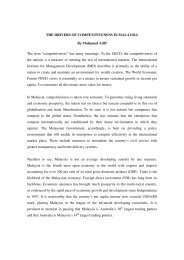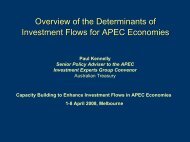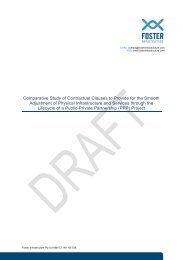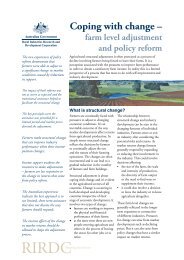Market Entry Strategies into China for Australian Companies
Market Entry Strategies into China for Australian Companies
Market Entry Strategies into China for Australian Companies
- No tags were found...
Create successful ePaper yourself
Turn your PDF publications into a flip-book with our unique Google optimized e-Paper software.
AdvisoryTransaction Services Strategy Group<strong>Market</strong> <strong>Entry</strong> <strong>Strategies</strong><strong>into</strong> <strong>China</strong> <strong>for</strong> <strong>Australian</strong><strong>Companies</strong>*connectedthinking•
<strong>Market</strong> <strong>Entry</strong> <strong>Strategies</strong> <strong>into</strong> <strong>China</strong><strong>for</strong> <strong>Australian</strong> <strong>Companies</strong>• Business opportunities in <strong>China</strong>• Business issues and challenges• <strong>China</strong> market entry strategies• How PwC can helpTransaction Services Strategy GroupPricewaterhouseCoopers
Business opportunities in <strong>China</strong><strong>China</strong> is now one of the largest and fastest growingeconomies and markets in the worldUS<strong>China</strong>JapanIndiaGermanyFranceUKItalyBrazilWorld’s Top 10 PPP GDP Ranking, 20031,6001,4001,2001,0008006004002000<strong>China</strong>’s GDP and Growth Rate Comparison(US$ billion)9.1%7.5%Estimated1998 1999 2000 2001 2002 2003 2004Russia(US$ billion)0 2,000 4,000 6,000 8,000 10,000 12,000<strong>China</strong>'s GDP<strong>China</strong>'s annual GDP growth rateMiddle income countries' annual GDP gowth rateOECD countries' annual GDP growth rateLower middle income countries' annual GDP growth rateTransaction Services Strategy GroupSource: 2003 <strong>China</strong> Yearbook, World Bank Data Query Website. GDPand GDP growth rate <strong>for</strong> 2004 are estimated by MOFCOM10%9%8%7%6%5%4%3%2%1%0%4
Business opportunities in <strong>China</strong>…which offer attractive opportunities <strong>for</strong> <strong>for</strong>eign investmentsServices 6%As <strong>China</strong>’s economic structureupgrades, the sector has beengrowing at 16% annually and accountsaround 4% of the total GDP.However, opening up to FDI is agradual processReal estate 13%With <strong>China</strong>’s large population andhousing welfare system re<strong>for</strong>m, thegrowth rate has been over 10% andaccounts <strong>for</strong> around 2% of the totalGDPWholesales, retail andcatering 3%Transport, storage, postal andtelecommunication services 4%The sector is growing fast from itsunder-developed stage to around 6% ofthe total GDP. In particular,telecommunication services has beengrowing with an annual rate over 30%.Industry Distribution of Foreign InvestedCapital in <strong>China</strong>’s FIEs as of 2002Construction 2%Power, Gas andwater supply 3%Others 7%Manufacturing 62%1. Manufacturing accounts <strong>for</strong>around 44% of the total GDP.2. Some manufacturing sectorssuch as automotive grow asmuch as 30% annually.3. <strong>China</strong>’s low production cost andhuge market potential has made<strong>China</strong> the manufacturing centrein the world4. Manufacturing is opened to<strong>for</strong>eign investment relatively earlyand less regulated than manyother sectors5. From garment and toy toconsumer electronics and toautomotive, different sub-sectorshave been driving FDI <strong>into</strong>manufacturingTransaction Services Strategy GroupSource: 2003 <strong>China</strong> Yearbook5
Business opportunities in <strong>China</strong>The economic growth is driven by major economic andindustrial trans<strong>for</strong>mations• Increasingly becoming theworld factory - outsourcedmanufacturing as part ofglobal supply chain ormanufacturing migrationDeregulation• WTO enables increasedmarket access across anumber of industries• <strong>China</strong> is also creatingopportunities <strong>for</strong> regionalsupply chain<strong>China</strong> <strong>Market</strong>GlobalisationTrans<strong>for</strong>mation andPrivatisationGrowth• Massive migration of SOEs<strong>into</strong> shareholding structures• Moving quickly towards amarket economy• Emergence of POEs asmajor growth engine andeconomic driving <strong>for</strong>cesEconomic liberalisation• Retreat of state ownershipin most competitive marketsegments• The private sector nowdominates <strong>China</strong>’seconomyTransaction Services Strategy Group6
Business opportunities in <strong>China</strong>Although growing, Australia’s direct investment in <strong>China</strong> onlyaccounts <strong>for</strong> less than 1% of the total FDI inflow to <strong>China</strong><strong>Australian</strong> Foreign Investment Amount in <strong>China</strong> andIts Share in the Total FDI Inflow to <strong>China</strong>FDI Inflow to <strong>China</strong> Ranking by Origin (2002)4000035000300002500020000US$ 10thousandAs percentage of<strong>China</strong>’s total FDI inflowFDI from Australiato <strong>China</strong>1.00%0.90%0.80%0.70%0.60%0.50%HKBVIUSJapanTaiwanKoreaSingapore150000.40%Kayman Island0.30%100000.20%GermanyUK50000.10%…00.00%AustraliaUS$ million1998 1999 2000 2001 20020 5000 10000 15000 20000Transaction Services Strategy GroupSource: 2003 <strong>China</strong> Foreign Economic Yearbook7
Business opportunities in <strong>China</strong>However, Australia’s FDI to <strong>China</strong> is still a relatively significantpercentage to its overall FDI outflowFDI Outflow to <strong>China</strong> as Percentage of Total FDIOutflow of the Country or Region (2002)KoreaTaiwanHKSingapore• Geographical proximity andcultural similarity can explain therelative importance of <strong>China</strong> as amajor FDI destination <strong>for</strong> thesecountries and regions.JapanAustraliaUS• Although the absolute amount isless impressive, <strong>China</strong> is still oneof the most important FDIdestinations <strong>for</strong> AustraliaGermanyUK0% 10% 20% 30% 40% 50% 60% 70% 80% 90% 100%Transaction Services Strategy GroupSource: 2003 <strong>China</strong> Foreign Economic Yearbook, UNCTAD FDI Database• Although the absolute amount ofFDI outflow to <strong>China</strong> from thesecountries is huge, it is morescattered.8
Business opportunities in <strong>China</strong>Compared with other countries, Australia has invested largerpercentage of its total investment in the services and miningsectorComparison of FDI Industry Distribution (2002)ManufacturingReal estate and business servicesWholesale and retailMiningIndustry distribution of totalFDI <strong>into</strong> <strong>China</strong>Industry distribution of FDIfrom Australia <strong>into</strong> <strong>China</strong>Financial ServicesTransportation and warehousingConstructionPower, Gas and Water SupplyEducationIn<strong>for</strong>mation Services0% 10% 20% 30% 40% 50% 60% 70% 80%Transaction Services Strategy GroupSource: 2003 <strong>China</strong> Yearbook, An Analysis of FDI from Australia in <strong>China</strong>, WuChongbo9
Business opportunities in <strong>China</strong><strong>Australian</strong> companies are tapping the market growth in <strong>China</strong>based on their capabilitiesGrowth Rate of <strong>China</strong>’s Fast Growing Industriesthat Draw Most <strong>Australian</strong> Direct Investment(2000-2002 CAGR)OpportunitiesExample of <strong>Australian</strong>entrantsMining and Dressing• Rich pool of resources• Need fund and technology upgradeRio T<strong>into</strong>, WMCResources, etc.Real estate• Housing welfare system re<strong>for</strong>m• Strong market demandLand lease, AustralandHoldingsConstruction• Infrastructure construction boomLeighton Holdings, Boral• Heavy commercial & residential building investmentSocial Services• Further deregulation and opening up• Demands upgrade with economic developmentMallesons StephenJaques,EducationFinancial Services• English language education, professional andvocational training, higher degree education are themost heated sectors• Further deregulation and opening up• Financial system re<strong>for</strong>m is under wayOrangewood Language,NITANZ Bank,Commonwealth Bank,QBE Insurance, etc.ManufacturingTransportation andWarehousingWhole sale and retail0% 5% 10% 15% 20% 25% 30% 35%Transaction Services Strategy GroupSource: 2003 <strong>China</strong> Yearbook• Manufacturing as percentage of GDP is rising• Such sectors as automotive is growing at 30%annually• Some sectors such as road and aeroplanetransportation grow faster with the structuralchange• Further deregulation and opening up• Whole supply chain integrationBlue Scope Steel,CSR,Lemarne, etc.P&O, Pioneer RoadServicesFuturis Corporation, AWB,ERG10
Business opportunities in <strong>China</strong> – future trend<strong>Australian</strong> companies should determine their strategic focus in<strong>China</strong> along the industry value chainThe manufacturing value-add crunch2000 Resources/ tangible inputs Assembly/manufacture Brand/logistics/design/marketingValue crunch Current VA on lo-tech,labor-int product ≅ 4% retail(20% mfg add x 20% exfac/rp)Value crunch2010<strong>Australian</strong> economy builthere, massive resourcesales (iron ore, LNG, wool,manganese, coal), now instrong future valueposition as commodityprices begin climbTaiwan economy built here,few significant brands,control of channels, ordesign cap. Lean and ultraleancontract manufacturing<strong>China</strong> in same modeEven at early stages, Japaneseeconomy built here, strongbranding, control of trade andchannels, strong designs. Nosignificant toll mfg or contractmanufacturingS. Korea in same modeTransaction Services Strategy Group12
<strong>Market</strong> <strong>Entry</strong> <strong>Strategies</strong> <strong>into</strong> <strong>China</strong><strong>for</strong> <strong>Australian</strong> <strong>Companies</strong>• Business opportunities in <strong>China</strong>• Business issues and challenges• <strong>China</strong> market entry strategies• How PwC can helpTransaction Services Strategy GroupPricewaterhouseCoopers
Business issues and challenges in <strong>China</strong>Management integrity, corporate governance and managementcontrol are among top concerns <strong>for</strong> <strong>for</strong>eign investors investing in<strong>China</strong>CorporatePrivate EquityHigh5.0High5.04.54.54.04.03.53.53.03.02.52.52.02.01.51.51.01.00.50.50.0Low0.0LowIntegrity of managementQuality / transparency of in<strong>for</strong>mationManagement controlTax, regulatory, legal concernsQuality of corporate governanceCurrency issuesGovernment's commitment to changeImpact of WTOImmaturity of domestic capital marketsIntegrity of managementQuality of corporate governanceQuality / transparency of in<strong>for</strong>mationTax, regulatory, legal concernsManagement controlCurrency issuesImmaturity of domestic capital marketsGovernment’s commitment’to changeImpact of WTOSource: PwC Survey of Foreign Investors in <strong>China</strong>, 2003Transaction Services Strategy Group16
Business issues and challenges in <strong>China</strong>Addressing financial, tax and HR issues early in a set-up ortransaction reduces implementation costsCommon Financial IssuesCommon Tax IssuesCommon HR Issues• Reliance on group companies <strong>for</strong> supportingservices/facilities• Inadequate employee entitlement provisions• Different business goals of joint venturepartners• Transactions take a long time to complete• Inadequate post-deal planning• Poor quality/unreliable financial in<strong>for</strong>mation• Inadequate access to in<strong>for</strong>mation• Poor <strong>for</strong>ecasting and projections• Title to assets unclear• Valuation of assets• Idle/under-utilised assets• Status of land use rights• Improper accounting practices <strong>for</strong> intangibles• In<strong>for</strong>mal arrangements andrelated parties• …• Non-compliance with the tax orcustoms regulations• Black marks from last tax/customsinspection• Uncertainty in the entitlement to thetax preferences• In<strong>for</strong>mal arrangement with local taxauthorities without <strong>for</strong>mal approval• Transfer pricing exposure• Unfulfilled withholding responsibility• Allowable loss carry <strong>for</strong>ward unclearInadequate tax provision• Control of bonded goods inappropriate• Non-compliance with tax registrationor invoice management requirement• Inadequate planning <strong>for</strong> transactionaltaxes• …• No available pool of enoughqualified talents• Non-compliance with the local HRand labour laws and regulations• Special training & developmentneeded to align local staff’s skillsand competencies with thecompany’s requirement• Imbalance between labour costsaving and talents attracting andretaining• Cultural incompatibility• Obstacle to organizational andstaffing change• …Transaction Services Strategy Group17
Business issues and challenges in <strong>China</strong><strong>Australian</strong> companies may also face strategic issues tocompete and survive on the local marketplaceHKJapanUSBVIKoreaUKSingaporeGermanyFranceTaiwanSwitzerlandNetherland…IrelandHungaryDenmarkBahamasNumber of Invested <strong>Companies</strong> Ranked as the Top500 FIEs with Largest Sales Revenue, 2003~30countriesor regionsin total0 20 40 60 80 100 120 140 160Transaction Services Strategy Group• Though the top 500 weredistributed among 30countries or regions,there is no <strong>Australian</strong>invested companiesSource: Invest in <strong>China</strong> WebsiteCompared with competition from theUS, EU and Japan in <strong>China</strong>,<strong>Australian</strong> companies is usuallydisadvantaged in• Scale• Brand recognition and reputation• Global network• Integration opportunities• Local expertiseStrategic Fit is a Must<strong>Australian</strong> companies areadvantaged in:• Advanced technology in certainindustries and sectors• Industry strength complementary to<strong>China</strong>’s• Experience and expertise in servingsome segments18
<strong>Market</strong> <strong>Entry</strong> <strong>Strategies</strong> <strong>into</strong> <strong>China</strong><strong>for</strong> <strong>Australian</strong> <strong>Companies</strong>• Business opportunities in <strong>China</strong>• Business issues and challenges• <strong>China</strong> market entry strategies• How PwC can helpTransaction Services Strategy GroupPricewaterhouseCoopers
<strong>China</strong> market entry strategies<strong>Market</strong> evaluation – should you be there?What are the WTOregulatory changes andimplications specific toyour business?What are the customers’needs, buying behavioursand key success factors inserving the customers?<strong>Market</strong> EvaluationWhat are the industrystructure, competitorlandscaping, competitivepositioning in the marketsegment?Transaction Services Strategy GroupWhat are the marketopportunities (market size,growth, segmentation)? Isthe market attractive tocurrent and potentialparticipants?20
<strong>China</strong> market entry strategies<strong>Entry</strong> strategy development – how do you get there?HighAcquisitionDegree of Risk / ComplexitySupplier AgreementsPurchase agreementLowOperating Joint VentureEquity InvestmentShared Distribution ChannelManufacturingProduct LicensingR&D Cost SharingDegree of CommitmentLow HighTransaction Services Strategy Group21
<strong>China</strong> market entry strategies<strong>Entry</strong> execution – getting there?How to get licenses andregulatory approvals?Which location to enter?Which partner to establish ajoint-venture or alliance?<strong>Entry</strong> ExecutionWhich targe to acquire <strong>for</strong>M&A?Value chain analysis Operation process analysisTransaction Services Strategy Group22
<strong>Market</strong> <strong>Entry</strong> <strong>Strategies</strong> <strong>into</strong> <strong>China</strong><strong>for</strong> <strong>Australian</strong> <strong>Companies</strong>• Business opportunities in <strong>China</strong>• Business issues and challenges• <strong>China</strong> market entry strategies• How PwC can helpTransaction Services Strategy GroupPricewaterhouseCoopers
How PwC can helpInvestment success in <strong>China</strong> remains a demanding exercise,but the steps are clearPhase 1 Phase 2Phase 3Phase 4Phase 5BusinessOpportunityAssessmentCandidatesSelectionDue DiligenceTransactionStructuring &ClosingPost DealSupportWhatweassistBestPracticeIdentify businessopportunity, evaluatemarket entryobjectives andoptions, and assessthe strategic rationale<strong>for</strong> acquisitions,investments oralliances• Opportunities arebest where there is afavorable intersectionof regulatory spacewith market demand• Aggressively studythe market <strong>for</strong> thehighest value spotIdentify, screen andrank acquisition,investment or alliancetargets based onstrategic attractivenessand transaction risk• The ideal targetsare those withstrategic fit• Have realisticsynergy expectationPer<strong>for</strong>m target duediligence• Commercial• Financial• Operational• Management• Undertake extremediligence on alldomestic entities thatare material to yoursuccessStructure terms of thetransaction and advicemanagement innegotiation and closing• New structuraloptions and complextax requirements candetermine success orfailure• Explore and model indetail all the structuraloptions, with a view tooperational efficiency,scalability, and taxefficiencyAssist in post dealremediation issuesand integration• Build a robust,responsive, andsustainableorganization• Build an organizationthat is closelyconnected to thecorporate center andthe domestic marketTransaction Services Strategy Group24
















